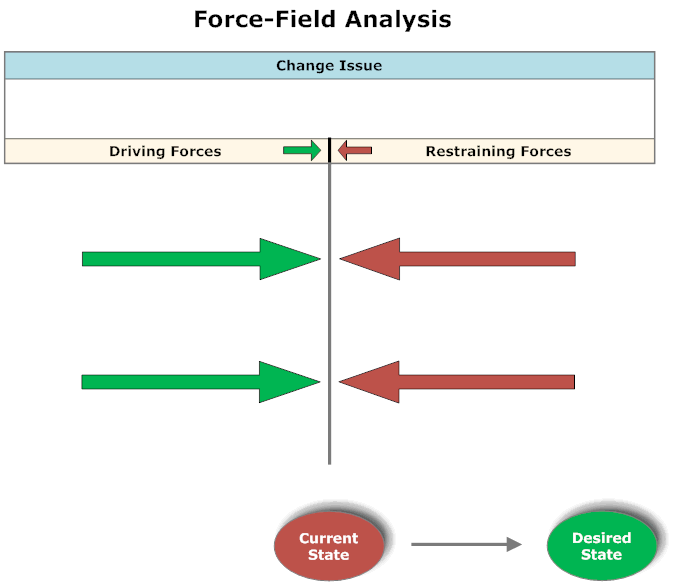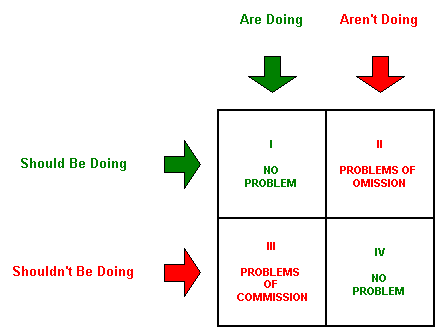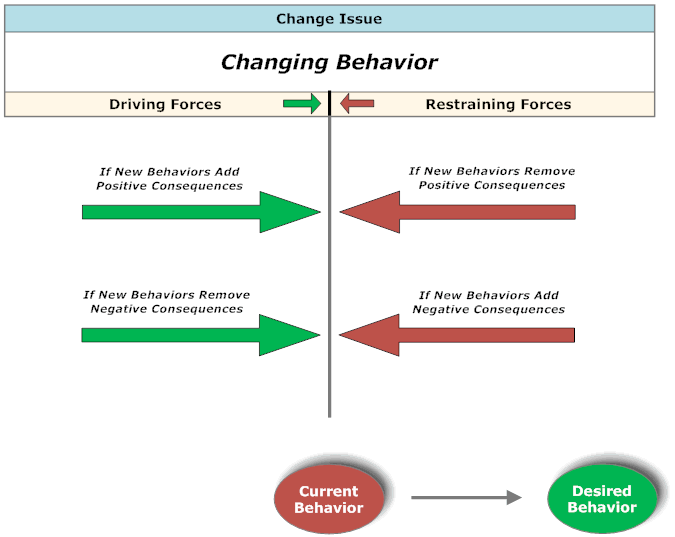

My Objective is to Help You Achieve Yours
|
Changing Someone Else's BehaviorFactors to Consider © Fred Nickols 2012
|
||||||||||||||||||||||||||||||||||||
This is the second of two articles I
published under the pen name, Peter W. Taylor. This one appeared in Performance and
Instruction. Joe Harless, a well-known figure in training and human performance
circles, was so taken with the integration of force field analysis and reinforcement
theory presented in this article that he dashed off a note to the mythical Peter W.
Taylor. (Darn! I should have published it under my own name).IntroductionA close friend and colleague of mine, a manager at the same firm where I am employed, sought my assistance recently in analyzing the problems presented by the behavior of one of the supervisors reporting to her. As it turns out, my friend (let's call her Ruth from here on) was up against two very different kinds of behavior problems. One involved getting the supervisor to stop doing some things. The other required getting the supervisor to start doing some other things. During our discussion, we had occasion to touch on ideas and concepts drawn from Allen Newell and Herbert Simon's theory of human problem solving, Kurt Lewin's force field theory (as described by Gordon Lippitt), and B. F. Skinner's reinforcement theory. What emerged from our discussion is a useful synthesis, a partial integration of the ideas and concepts just mentioned -- a framework for examining problems where the general form of the solution involves changing someone else's behavior. This article presents that framework. The General Structure of A Problem SituationAll problem situations, regardless of the specific kind of problem, have the same general structure (see Figure 1). The three elements of this structure are:
Figure 1 - The General Structure of A Problem Situation
As Newell and Simon (1972) point out, "A person is confronted with a problem when he wants something and does not know immediately what series of actions he can perform to get it (p.72)." Hence the requirement to search for a solution, a way of getting from a to a'. In somewhat different terms, the problem state or A may be viewed as what is, the solved state or A' may be viewed as what should be, and the course of figuring out how to close the gap between the two constitutes the solution path. The practical implications of the general problem structure for Ruth were the requirements to specify very clearly the behaviors she wanted the supervisor to stop (What Is), those she wanted the supervisor to start (What Should Be), and to search for a solution in what is known about changing behavior. The Problem of ChangeAll problem situations share more than the general structure presented in the preceding section; they also can be attacked from two very different angles. One angle of attack is from the perspective of content, that is, the specific kind of problem, be it a "behavior" problem, a "business" problem, a "performance" problem, or a "production" problem. The other angle of attack is from the perspective of process. Here, the problem -- regardless of type -- is cast as a problem of change, that is, the tasks are to unfreeze the current or problem situation, intervene, and then refreeze the resultant future state (which, it is hoped, is the one defined as the solved state). This separation of process and content is not new to professional problem solvers. It is reflected in the ways dominion over content and process are allocated in the disciplines of instructional technology, performance technology, organization development, and artificial intelligence (see Table 1).
|
|
Discipline |
Dominion over Content |
Dominion over Process |
|
Instructional Technology |
Subject Matter Expert (SME) |
Instructional Designer |
|
Performance Technology |
Master Performer |
Performance Technologist |
|
Organization Development (OD) |
Client |
Consultant |
|
Artificial Intelligence |
Domain Expert |
Knowledge Engineer |
That all problems may be viewed as having a change or process component led Ruth to realize she could and should consider the problems with which she grappled as general problems of change as well as specific problems of behavior. This, in turn, led us to discuss Kurt Lewin's force field analysis as a general diagnostic technique.
The current situation -- in Ruth's case, the current behavior patterns of the supervisor -- may be viewed as a response to a complex set of interacting and essentially opposing forces. Lewin termed this a field of forces. Many behaviorists might call it the "balance of consequences."
Some of these forces may be said to "drive" changes away from the current state toward other conditions, desired states, or behaviors and some may be said to "restrain" changes (see Figure 2).

Figure 2 - Force Field Analysis of A General Problem
If the situation is stable, these driving and restraining forces may be said to be in dynamic balance. A state of homeostasis exists. As this dynamically-balanced field of forces changes, so does the situation (and, in the case of people, so does behavior).
Identifying, analyzing, and then attempting to systematically modify this field of forces so as to bring about some predetermined change in the situation (i.e., to move from the current state to the desired state -- from point a to point a' in Figure 2) is one approach to what many people call "planned change."
The important points here for Ruth were as follows:
Let us now examine the more specific kinds of problems that triggered the discussion with Ruth.
Behavior problems fall neatly into two categories: Problems of omission, and problems of commission (see Figure 3). Problems of omission occur when people aren't doing what they should be doing. Problems of commission occur when people are doing something they shouldn't be doing.

Figure 3 - Problems of Omission and Commission
The general form of the solution for each of these two types of problems is the mirror-image of the solution to the other.
The change problem to be solved in the course of solving a problem of omission is to have someone start doing something they have not been doing.
In the context of force-field analysis, this requires increasing the driving forces and decreasing the restraining forces.
For a problem of commission, the objective is to have someone stop doing something they have been doing. Here, the change strategy is reversed. One must decrease the forces that sustain current behavior patterns and increase those forces that might restrain them. (These mirror-image strategies are summarized in Table 2 below.)
Type of Problem |
Type of Change |
Required Impact on Driving Forces |
Required Impact on Restraining Forces |
Omission |
Start |
Increase |
Stop |
Commission |
Stop |
Decrease |
Increase |
The point stressed to Ruth during this aspect of our discussion was that there is no single solution to her problem -- that she must adopt one set of strategies for getting the supervisor to stop certain behaviors, and employ a different set of strategies for getting the supervisor to start certain other behaviors.
Of importance here also was the fact that, in Ruth's mind, the start and stop behaviors were clearly separate from one another. The behaviors the supervisor was to start were not intended as replacements for those she was to stop. Such clean separation is not always the case. Indeed, frequently it is the case that the behaviors we wish started are substitutes for those we wish stopped. At any rate, this was not a situation wherein one set of behaviors was being substituted for another.
The perceived effects and consequences of our behavior form the basis for confirming or disconfirming our behavior.
The likelihood that we will or won't engage in a particular behavior is governed in large part by our expectations or predictions of the effects and consequences of that behavior in relation to our goals and objectives; in other words, the extent to which it serves our purposes.
An incident from my days as an OD consultant will make this point far better than any contrived example can.
Shortly after a very lively interpersonal skills training session, one of the participants (let's call him Dick) confronted another (whom we'll call Ray) in the hallway outside the seminar room.
Said Dick, "Ray, I've got some feedback I'd like to share with you."
Said Ray, "Sure, Dick, I'm always interested in improving my effectiveness."
This little ritual out of the way, Dick proceeded to enumerate a long list of very specific behaviors on the part of Ray that annoyed Dick to no end. When he finished his inventory of Ray's offending behaviors, Ray replied as follows.
"Dick, that's the best news I've had in a long time. You see, I've been trying to tick you off for months, now, and I had no idea I was being so successful. Thanks for the feedback."
Exhortation or encouragement by others to do this or that, and any rewards, incentives, or disincentives they might offer, no matter how powerful, are merely more ingredients in what is a very complicated mix of factors that determine behavior.
Because the anticipated driving and restraining forces exist only in the minds and imaginations of those whose behavior has been targeted for change, it is extremely difficult for others to independently manipulate these driving and restraining forces. Instead, would-be change agents must deal with the perceptions and expectations of those whose behavior is to change.
Now it so happens that the perceived and anticipated consequences of behavior also fall neatly into two categories: Positive and Negative. Thus, the predicted effects of a given behavior can be perceived as adding or subtracting positive or negative elements to or from the existing balance of consequences that maintains present behavior patterns (see Table 3).
B. F. Skinner (1965) defined positive reinforcement as adding something positive to the situation, and negative reinforcement as removing something negative (p.73). He also observed that the two forms of punishment consist of adding a negative or taking away a positive (p.185). Both sets of concepts are depicted in Table 3. (Parents should have no trouble identifying them, respectively, as praising, slacking off, spanking, and grounding.)
EFFECTS OF BEHAVIOR |
SYMBOLS |
TECHNICAL TERMS |
Adds Positive Conditions Subtracts Negative Conditions |
(+ +) (- -) |
Positive Reinforcement Negative Reinforcement |
Adds Negative Conditions Subtracts Positive Conditions |
(+ -) (- +) |
Positive Punishment Negative Punishment |
The table above may be read as follows:
One key point for Ruth was that the determination of what is positive and what is negative is made by the supervisor. Another was that the only way Ruth could hope to understand and ultimately influence the supervisor's behavior was as a result of discussions with the supervisor regarding the supervisor's goals and objectives, and the effects the supervisor's behavior was having on others and in terms of her own goals and objectives.
In general, the expectation of obtaining positive conditions tends to entice people toward a given behavior and the expectation of obtaining negative conditions tends to restrain them from trying that behavior. Further, the prospect of losing some existing positive condition acts to restrain people from engaging in new behavior; however, the prospect of eliminating some existing negative condition acts as an incentive or driving force.
The determinants of behavior depicted in Table 3 are consistent with the structure of force field analysis. Moreover, by arraying reinforcers and punishers as drivers and restrainers, another useful analytical model can be constructed (see Figure 4).
As regards problems of omission and getting people to engage in new behaviors, it is essential to understand that new behaviors, in the eyes of the persons expected to engage in them, must be seen as leading to positive consequences. Most important, once displayed, these new behaviors must be confirmed.
As regards problems of commission and getting people to stop what they are doing, it is equally essential to understand that current behaviors, at least in the eyes of those doing the behaving, are and have been confirmed by experience. (Whether or not this experience can be said to be informed or rational is immaterial.)
People do what they do because that's what they know how to do, and because it has worked for them in the past. Thus, for people to stop what they are doing, their current behavior patterns must first be disconfirmed. They must conclude that their current behavior no longer serves them well.
In this same vein, it is absolutely crucial to recognize that people don't oppose change because some new state of affairs promises to be worse than an existing one. Instead, they oppose change because the existing situation is known and certain, whereas the new situation is unknown and uncertain.
No one knows what the future holds. It might be better, it might be worse. When people are asked to change, they're typically asked to swap a sure thing for a maybe, a known for an unknown. Most people are reluctant to make such a trade -- except when current conditions are seen as so bad that anything else must be better.

Figure 4 - A Field of Reinforcing and
Punishing Forces
In general, as implied by Figure 4, people will move toward new and different behaviors if they view these new and different behaviors as:
Typically, people will shy away from new and different behaviors if they view these new and different behaviors as:
And what of the original problem that gave rise to all the discussion with my colleague, Ruth, a discussion that is only hinted at in the paragraphs above?
Well, Ruth is doing what I think is the smart thing under the circumstances. She is thinking through all that we discussed before making any rash moves.
It has dawned on her that changing someone else's behavior is a very complicated and difficult undertaking. Such a task far transcends simple notions of rewards and punishment, and it encompasses much more than the belief that changing someone else's behavior is a matter of methodically manipulating the contrived consequences of their behavior.
This page last updated on August 2, 2019